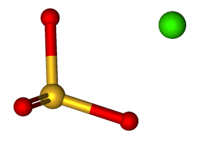Calcium sulfite
 | |
 | |
| Names | |
|---|---|
| IUPAC name
Calcium sulfite | |
| Other names
Sulfurous acid, calcium salt (1:1) E226 | |
| Identifiers | |
| 10257-55-3 | |
| ChemSpider | 8329549 |
| Jmol interactive 3D | Image |
| PubChem | 159274 |
| |
| |
| Properties | |
| CaSO3 | |
| Molar mass | 120.17 g/mol |
| Melting point | 600 °C (1,112 °F; 873 K) |
| 0.0043 g/100 mL, 18C | |
| Hazards | |
| Flash point | Non-flammable |
| Related compounds | |
| Other anions |
Calcium sulfate |
| Other cations |
Sodium sulfite |
| Except where otherwise noted, data are given for materials in their standard state (at 25 °C [77 °F], 100 kPa). | |
| | |
| Infobox references | |
Calcium sulfite, or calcium sulphite, is a chemical compound which is the calcium salt of sulfurous acid with the molecular formula CaSO3. Some common uses areits production in flue gas desulfurization (FGD), as a food additive, and in the production of calcium sulfate. It commonly reacts to create calcium sulfite hemihydrate when in the presence of moist air.
Uses
Wood Pulp Production
Calcium sulfite can be used in the production of wood pulp through the Kraft Process. Chemical wood pulping is the removal of cellulose from wood by dissolving the lignin that binds the cellulose together. Calcium sulfite was used, but has been largely replaced by magnesium and sodium sulfites and bisulfites to attack the lignin[[1]].
Food Additive
As a food additive it is used as a preservative under the E number E226. It is commonly used in preserving wine, cider, fruit juice, canned fruit and vegetables.[2] Sulfites are strong reducers, as sulfate formation is favored so they act as somewhat of an O2 scavenger to preserve food.[3]
Drywall
CaSO3 is not a desirable compound in drywall due to its long-term chemical instability, as it reacts with water to make calcium sulfate, reducing the integrity of the drywall.
The reaction converting the sulfite ion to the sulfate ion is very favorable under SATP[3] (Keq= 6.66 x 1044). It is important to note that this is not in the salt, but shows the incredible favorability of the sulfate.
SO32− + ½ O2 → SO42−
Synthesis
One way calcium sulfite can be produced is the reaction between calcium chloride and sodium sulfite.[1]
CaCl2 + Na2SO3 → CaSO3 + 2NaCl
This is done in solution, and calcium sulfite dehydrate is formed. This is dehydrated at 150 °C. If Ca(OH)2 is used instead of CaCl2, calcium sulfite hemihydrate is formed instead which has an orthombic structure.[4] Calcium sulfite has a hard, crystalline structure.[5]
Flue gas Desulfurization
When coal is burned, one of the byproducts is known as flue gas. This contains SO2, (sulfur dioxide gas). When in the presence of water in the atmosphere, it creates sulfuric acid by the following reactions.[6]
SO2 + OH· → HOSO2·
This then reacts with oxygen to create sulfur trioxide.
HOSO2· + O2 → HO2· + SO3
Sulfur trioxide immediately reacts with water to create sulfuric acid.
SO3 (g) + H2O (l) → H2SO4(aq)
H2SO4 is a strong acid, so the atmospheric clouds become acidic and acid rain results. Another mechanism for acidizing the atmosphere involves SO2 and liquid water.[7] This creates sulfurous acid.
SO2 + H2O → SO2.H2O
SO2.H2O → H+ + HSO−3
This reaction is less favourable than the previous but it still contributes to acidity in clouds.
Calcium Sulfite is produced in the process of flue gas desulfurization (FGD). This process became very common in the late 20th century due to environmental concerns like acid rain. FGD removes the sulfur dioxide to before the gaseous products are released. The two most popular methods of FGD are lime scrubbing and limestone scrubbing. Both use a slurry of ~10% CaSO3 along with either calcium hydroxide (lime) or calcium carbonate (limestone). What happens in limestone scrubbing is the following overall reaction:
SO2(g) + CaCO3(s) + 1/2 H2O(l) → CaSO3(s) .1/2 H2O + CO2(g)
Similarly, what happens in lime scrubbing is the following overall reaction:
SO2(g) + Ca(OH)2(s) + H2O(l) → CaSO3(s) .1/2 H2O + 3/2 H2O(g)[8][9]
Calcium sulfite is relatively worthless though, because it has very few uses. It can, however, be oxidized to produce gypsum or calcium sulfate dihydrate, which can be used commercially.[1][5] This oxidation reaction is the reason it is not stable in things like drywall, as it uses water and oxygen, common conditions in Earth's atmosphere.
This process is less used recently though, as it has been replaced with better processes, which use magnesium sulfite instead.
References
- 1 2 3 Ropp, Richard (2013). Encyclopedia of the Alkaline Earth Compounds. Elsevier Science Technology. pp. 145–148.
- ↑ "Calcium Sulfite". Chemspider. Retrieved December 12, 2014.
- 1 2 Hoa, Dick W. (2000). "Environ. Sci. Technology". Environ. Sci. Technology.
- ↑ Matsuno, Takashi (1984). "The crystal structure of calcium sulfite hemihydrate". Bull. Chem. Soc.
- 1 2 Kohl, Arthur (1997). Gas Purification. Gulf Professional Publishing. p. 498.
- ↑ Margitan, James (1984). "Mechanism of the Atmospherlc Oxidation of Sulfur Dioxide. Catalysis by Hydroxyl Radicals". J. Phys. Chem. 88: 3314–3318. doi:10.1021/j150659a035.
- ↑ National Research Council (1982). Acid Deposition: Atmospheric Processes in Eastern North America. National Academies Press. p. 178.
- ↑ Hudson, JL (1980). Sulfur Oxidation in Scrubber Systems. University of Virginia.
- ↑ Miller, Bruce (2004). Coal Energy Systems. Elsevier Science Technology. pp. 294–299.